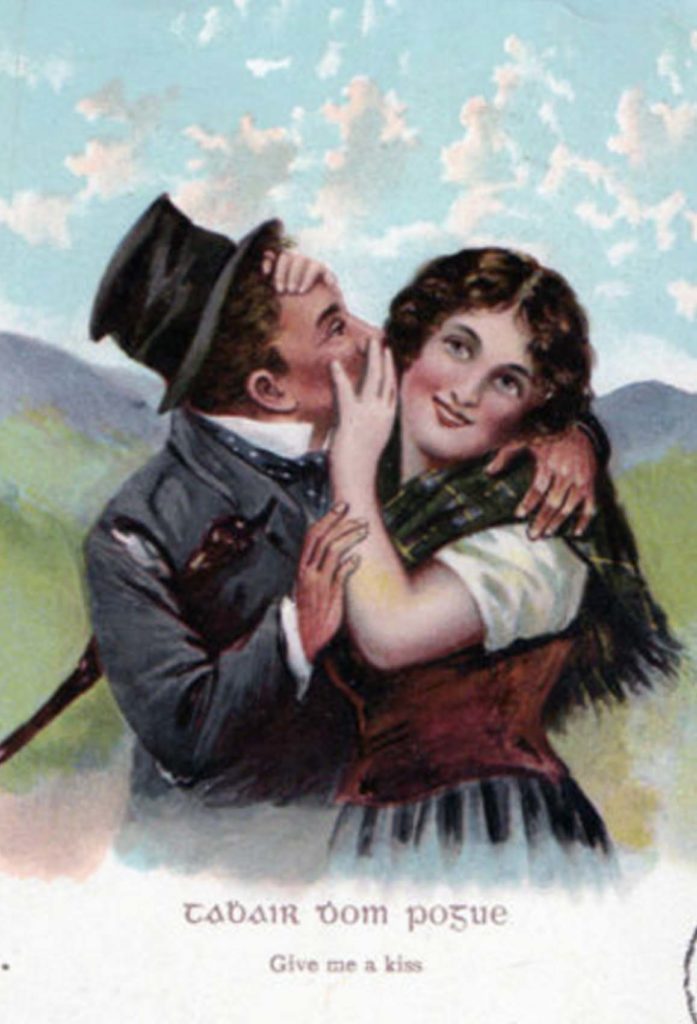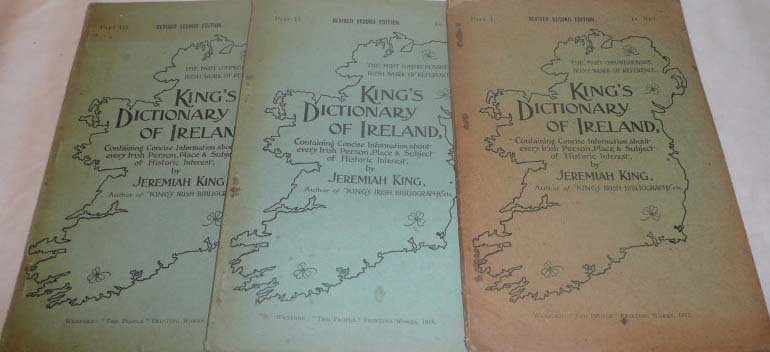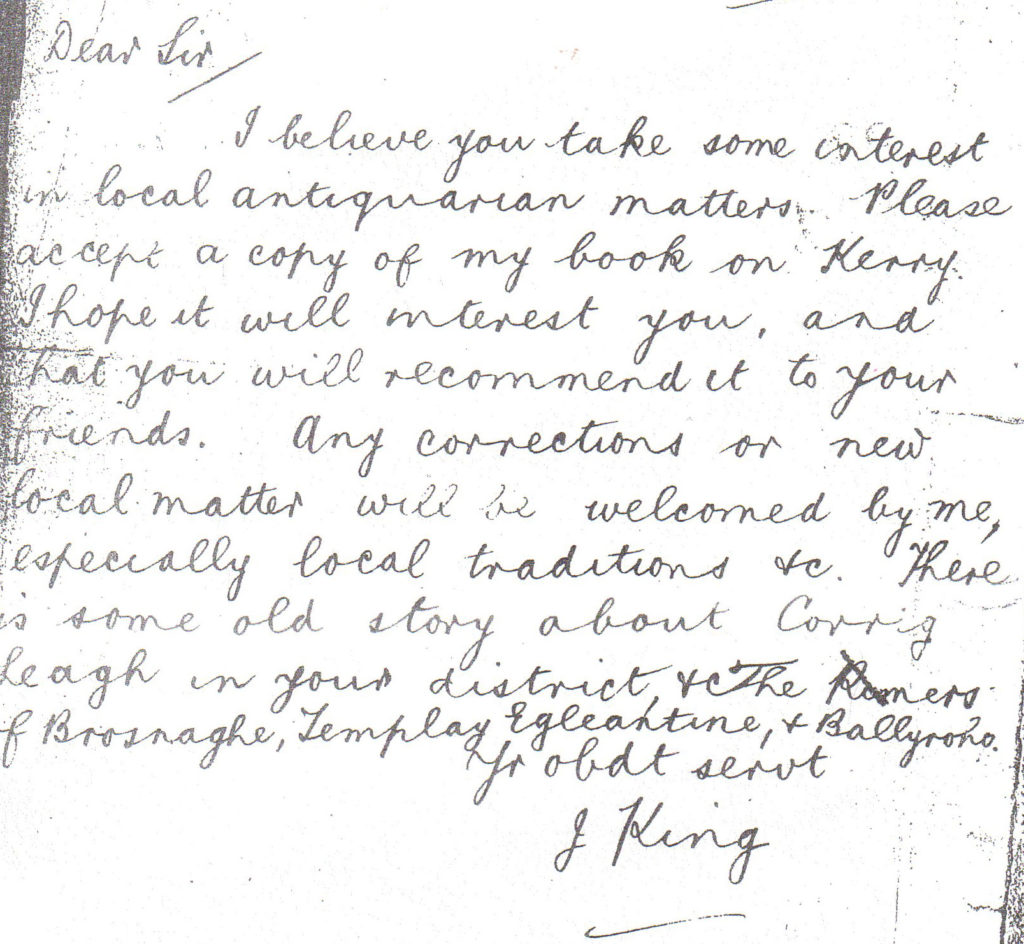As a researcher of Kerry history, Michael O’Donohoe took a natural interest in those of like mind who preceded him, including Kerryman Jeremiah King (1868-1927) or Diarmat Mac Conroi of Catair Conroi as he preferred to style himself.
Michael’s collection includes notes on Jeremiah King’s book, County Kerry Past & Present which he studied for its relevance to Castleisland. He also sourced a biographical sketch (and bibliography) of King by Edmund Moriarty (1995).
King’s vast collection
King’s County Kerry Past & Present was published in 1931, posthumously.1 A review of the book suggested that the scope of King’s research was best illustrated by the 28,845 Kerry households on which he wrote: ‘Householders whose dwellings are not grouped in orderly rows for classification purposes, but for the most part are widely scattered over miles of mountainside and bog’ (Yorkshire Post, 5 August 1931). Another review described the depth of King’s research:
No one not animated with a burning love of his native heath could have devoted himself to the study of his county’s history with King’s energy and patience. This handbook is small in bulk, but immense in content. I doubt if any single Irishman has ever before gathered together between two covers such a vast collection of curious, miscellaneous information (Irish Examiner, 28 May 1932).
.
Maurice McElligott, writing from the Author’s Club, London, defended the work of ‘his late friend’ King in a letter to the editor of the Kerryman:
During his lifetime, King got little credit and less money for his extraordinarily painstaking work which was borrowed without acknowledgement by every village pirate. Now that he is gone, the foul game continues and unworthy, nameless scribes publish his stuff – and good stuff it is – over their unhallowed and contemptible aliases (The Kerryman, 12 December 1931).
British Museum ‘ransacked’
King worked as a customs officer in London and made ample use of his proximity to the British Museum:
He literally ransacked the British Museum and every other available source for books and manuscripts about Kerry … Much of his information was obtained from rare documents and dusty tomes in the British Museum where he appears to have spent most of his hours of leisure. The work occupied him for twenty years.
Edmund Moriarty described King as very much a self-made man: ‘He was his own agent, writer, editor, publisher, wholesaler and retailer’. He also alluded to him as ‘Kerry’s forgotten historian’. This may be attributed to the destruction of King’s papers in two fires, the first in the Central Catholic Library in 1932 and the second at Skidoo House in Dublin in 1949, where ‘virtually all of his remaining works’ were destroyed.
King died in 1927 without the satisfaction of seeing the combined results of his Kerry research in book form. A review of County Kerry Past & Present (IE MOD/42/42.1/42.1.3) referred to King’s earlier publication, History of Kerry, as ‘in many ways a more valuable book than the present one’.
King’s Phenomenal Output
King worked at a breathless rate. His pamphlets included King’s Irish Card Subject Index (c1903), King’s Bibliography of Irish Pictorial Postcards (1903), King’s Irish Bibliography (1903) King’s Dictionary of Ireland (1905) and The Liverpool Irishman or Annals of the Last Colony in Liverpool (1906).
King stated, in The Liverpool Irishman, that ‘Irish labour has helped to make Liverpool wealthy’ and noted such events as in February 1847, when 26,348 Irish landed in Liverpool.
In the introduction to the 16-pg King’s Irish Bibliography, King remarked that ‘unlike any other country, Ireland has no cyclopaedia to act as a guide book to her literature’. He gave this as his ‘apology for placing before the public’ his guide. King anticipated ‘much criticism from specialists’ but explained that the work was intended ‘mainly for the person who is interested in the whole of Ireland, be he Celt or Saxon … a ready reference to busy men’. King ‘avoided the old system of catalogue … life is now too short and books are too numerous to wade through catalogues in this way’. Instead, King placed subject first, ‘the authors are of secondary importance’.
A glance through the alphabetically arranged subject matter on the first page includes such things as Agitators, Airs, American Irish and Athlone, each opening up its own history. Under the latter title is found The Old Bridge of Athlone by Joly of Dublin. This was Rev John Swift Joly (1818-1887) whose works include The Wars of Nature (1870) and Earth’s Christmas Ode (1886).2
As with his Irish Bibliography, King’s Bibliography of Irish Pictorial Postcards was published from the address of 53 Khedive-rd, Forestgate. Indexed according to subject, it is a useful reference to the postcards in circulation in 1903. Kerry items include Ballybunion Men’s Bathing Strand, view from Hotel Metropole in Killarney and Listowel Spa. Elsewhere in the country, the Kilrush Hill motor race in Clare, boy goes courtin’ in Tipperary and Lawrence’s tabair dom pogue – give me a kiss! are listed.
We learn that Messrs Blum & Degen are ‘pioneers of pictorial cards since 1895’ – indeed, the bibliography gives notes on a number of companies, including T P O’Halloran, Valentine & Sons, Wrench Ltd, R Tuck & Sons, McCaw, Stevenson & Orr Ltd, Fergus O’Connor, Guy & Co, Stewart & Woolf, Lawrence and Hely’s who ‘have the most up-to-date plant for producing collotype cards … the recent views of the Royal Visit and the Gordon-Bennett Motor Race show interesting scenery’. The booklet also refers to the bibliographical works of Ernest Reginald McClintock Dix (1857-1936).
Dictionary of Ireland
King’s Dictionary of Ireland parts 1, 2 and 3 – at 1½d per copy – was advertised for sale in May 1905. It was later reissued by the Wexford People Printing Works in 1917. Part 4 was on sale in 1924: ‘This section deals with Irish persons, places and subjects from Galway to Lytton and the section P and Z is in the press. Parts 1 to 4 can be had by subscribers from J King, 64 Chancery Lane’. The Dictionary is rare.
History of Kerry Part I
King’s eye fell heaviest on his home county. In 1905, he began advertising for Kerry related material.

King’s History of Kerry (sometimes King’s History of County Kerry) began to appear in pamphlet form in 1907 ‘for the nominal sum of 1s’ and continued to 1911.
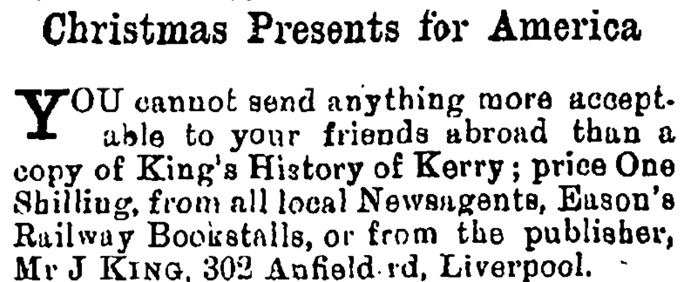
Those parts, packed with historical gems, are scarce today and, if you can find one, sell for considerably more than 1s. King set out his aim in Part I (1907):
It is proposed to deal with the history of Kerry in a series of chapters arranged according to parishes (87 in all) and giving details of each townland. The names of the townlands have been Anglicised to a considerable extent and I have to thank my friend and school-mate Mr William Buckley for giving the derivation of many of the names. Another Kerryman, Mr Patrick Brosnan, has also given much help in explaining the names of the townlands. The parishes will be found in alphabetical order – Aghadoe to Ventry.
The parish history extends over 89 pages. King’s synopsis of Castleisland (number 17 on his alphabetical list) begins with the foundation of the castle in 1226. He notes that in 1291 Castleisland church was known as Ecclesia de Insula. The 55 townlands of the parish are explained and a poem, The Geraldines, by Thomas Davis is included. Part I concludes with pages 90-125 which contain an impressive 253 notes and queries with index, each entry rich in history. By way of example, p112, note 180:
John Drake was a mysterious pilgrim who lived for ten years among the ruins of Mucross Abbey, about 1750. He was about forty years of age, of gentle and dignified manners, and an accent not of Munster. It was supposed he had committed some crime, and came to do penance within the haunted walls of the old church. He used as his bed the recess for the fire place in the refectory, and besides his ordinary clothes he had only a single blanket given him by his neighbour. He never asked alms, and had his food in the old abbey. He lived on fish, potatoes, and fruit. Visitors to the abbey so pitied him that they always said an extra Rosary for “the sins of poor John Drake”. He at last suddenly disappeared and was never seen again. Some ten years later a foreign wealthy lady came to inquire for him. She stayed some time in deep distress, gave alms to his old friends, wept in his haunts, and also disappeared.
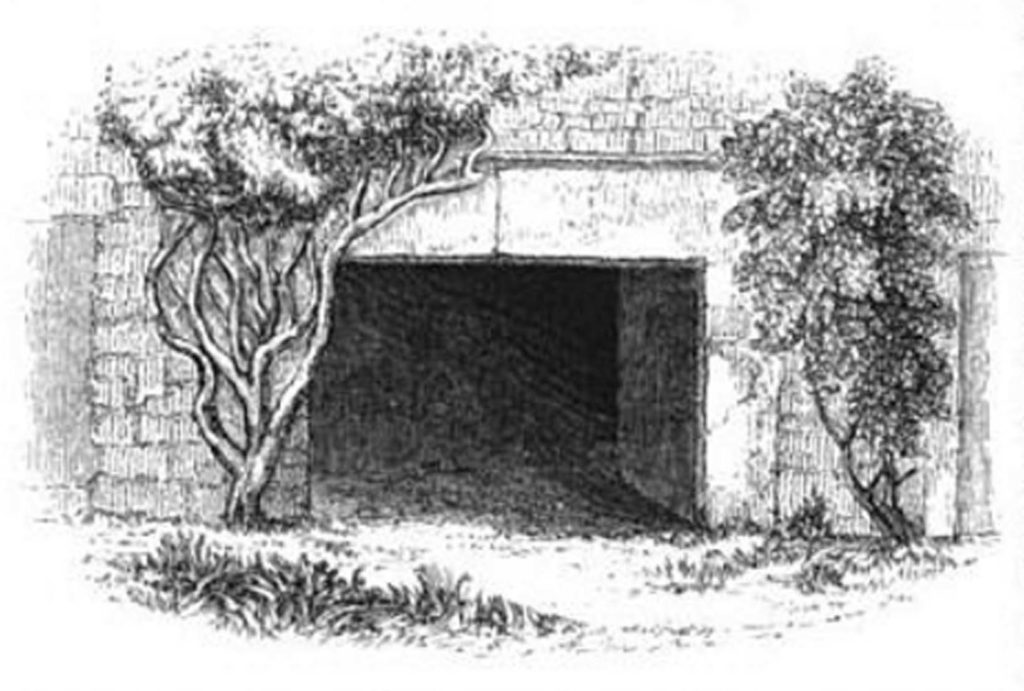
The Halls’ account of John Drake describes how local inhabitants, too afraid to enter the abbey after nightfall, asked John Drake if he had ever seen anything in the ruins to which he replied, ‘nothing worse than myself’.
History of Kerry Part II
On the introductory page of Part II (1909 pp126-191) King advised that ‘only 1,000 copies of each part will be printed. Part I is nearly sold out’. Part II, he wrote, ‘consists of antiquarian notes and queries. A full index is also given’.
The numbered notes continue from the notes and queries of Part I (254 to 451). A few illustrations from the first page will give an idea of the depth of his research:
Note 256: Patrons, Holy Wells and Race Meetings: There was a celebrated holy well, Tobernamull, on the old road to Abbeydorney and Ardfert, and another at Ballyseedy. Race meetings were held frequently at that time; at Ballyfinane in the winter; at Rahoneen strand in the autumn; at Tralee in April; at the Island, Listowel, in September and at Killarney in the harvest time. Could a list be compiled of Kerry patrons and holy wells? Note 259: Mulloghbert Hill was the meeting place of the O'Sullivan clan, where justice was dispensed and disputes adjusted. An O'Sullivan in America would like to find this place. Note 260 deals with the local traditions of Brosna parish, and there we learn that 'the O'Mahonys of Dunloe, Dromore and Kilmorna are all from the same stem, Cian, son of Maolmuadh and Sadb, daughter of Brian Boru'. Note 261 sought information on the family of Nicholas Madgett, RC Bishop of Kerry who 'built a residence in a narrow lane of Strand-street, Tralee for the sum of £16'.
King recognised the value of folklore. In note 287 he wrote:
Some historians and antiquarians reject the local stories and traditions as of no value in research. In most cases the fireside storyteller relates a curious medley mixing up Grecian history and Gaelic folk-lore with events of a century or two ago. The old learned bards and historians were well-trained men. There must be extant in Kerry many purely local traditions and folk tales which will bear the test of historical research. If any correspondents who know of such would write them down concisely and send them on to our column they would do valuable work by preserving in print traditions of Kerry which may be lost in another generation.
By way of illustration a mermaid legend of the Magherees was provided.
Castleisland woollen factory
King’s notes are varied and fascinating. An outline of the establishment of Castleisland woollen factory relates how Lord Powis desired to improve the town and hoped the factory ‘would be the means of covering the adjacent hills with fine flocks’. The project was being revived in 1908.
The history of the Eager family in Kerry (pp168-178) concludes part II. Pages 179-189 and 189-191 provide a useful index to the first two parts.
History of Kerry Part III
Part III (1910 pp 192-283) is a continuation of Part II, notes numbered 452- 458. In those notes King assembled a number of family histories in Kerry, including Stokes, Fuller, O’Halloran, Denny, Ginnis, Bernard, Moriarty, O’Rahilly and M’Carthy.
Note 453 is a chronological list of Catholic events in Kerry from AD 512 when St Erc (the first convert baptised by St Patrick at Tara) made Ardfert the seat of a bishop to 1904, the death of Most Rev John Mangan, bishop of Kerry. Along the way we learn such things as in the year 838, the northmen destroyed the churches of Kenmare and Innisfallen, in 1200 the bishop of Ardfert went to Rome to complain that the Archbishop of Cashel refused to consecrate him, in 1312 a leper house and castle was erected at Ardfert and in 1325 there was a dispute between friars and knights Hospitallers of Rattoo about Ardfert market cross and pillory.
In 1402 Brosna was let to farm to secular clerks and in 1542, Henry VIII issued a commission to the Earl of Desmond to dissolve the religious houses of Munster for the king’s use. The abbot of O’Dorney was shot in Lixnaw castle in 1577 and in 1901, Rev Denis O’Donoghue, author of Brendaniana (1893), a collection of material relating to St Brendan, died.
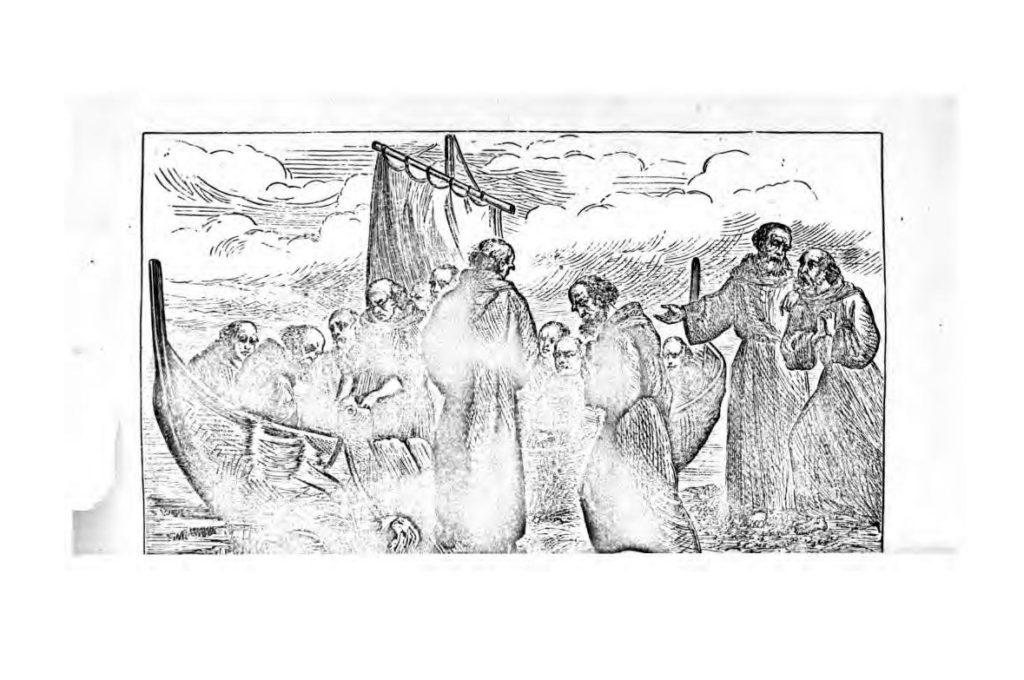
Note 454 relates to the hills and mountains of Kerry, such as Barabaha (crop of beech-trees) and Knockanefune (fair hill) both in Ballincuslane. To this King added a poem by Edward Walsh:
Now Maing's lovely border is gloriously won, Now the towers of the island gleam bright in the sun, And now Ceall-an-anamack's portals are passed,, Where headless the Desmond found refuge at last! By Ard-na-greach mountain and Avonmore's head, To the Earl's proud pavilion the panting deer fled.3
Note 457 (p214) contains notes on the castles and chief houses of Kerry, organised alphabetically by parish. At Currans we find Currans Castle was in 1756 the residence of George Herbert and in Ballincuslane, Kilcusnan Castle was another Desmond stronghold.
A list of names (alphabetically arranged) of settlers around Tralee from the times of Elizabeth to the rebellion of 1641 is also found in Part III. Names include Blennerhassett, Morrogh Bernard, Chute and Pepys. King extended his list (acknowledging the help of Rev H L L Denny for information gleaned from family papers) to names of settlers subsequent to 1641; names include Bateman, Comyn, Meredith and Hilliard.
History of Kerry Part IV
Part IV (1911 pp 284-353) contains Annals of Kerry BC1695 to AD1695. A fascinating outline of Irish history is drawn, for example, in the year 1299 is a description of the manor de Insula (Castleisland):
The manor is surrounded by a stone wall, and there is in it a hall constructed of pales with an earthen wall and thatched, a kitchen of planks, a chamber with a cellar built of stone and thatched, a chamber for women, a stable, a chapel of worn-out pales covered with straw, which houses they cannot set down at any price.
Castleisland mill (mill de insula) was at this time worth ½ mark (p292). Moving forward to 1402, the Earl of Desmond appears in the record: ‘Nemerus Oralyd rehabilitated for holding Killnanwayn (Kilmaniheen) vicarage and the victory of Traly from its patron, Gerald, Earl of Desmond (dessimonyie)’. The 11th Earl appears in 1528 (Jan 28):
Sir John Fitzgerald of Desmond and his son Gerald write to the king from Dromany that they have obeyed his commands and aided James Butler. For this aid James, the eleventh earl of Desmond, came with a host and burnt and destroyed the most part of their country (pp295-6).
Indeed, the death of Gerald, leader of the Desmond Rebellion, is set down:
1583 June 18. Ormond to the Queen. The Countess of Desmond has submitted simply. The Earl wanders from place to place forsaken of all men. 1583 June 22. Ormond. Desmond has only a priest, two horsemen, one kerne, and a boy. 1583 Nov 11. Desmond slain by the sept called the Imwrrihertaghes (Moriartys), aided by Lieutenant Cheston, the constable of Castlemaigne, at Glaneegnitye. 1583 Nov 15. Earl of Ormond, Kilkenny, to Burghley. On Monday last Donill M'Donill Imoriertagh, dwelling near Castell Mange, assaulted and slew the Earl of Desmond in his cabin at Glanegnictye near the river Mange. He had with him 25 kerne of his followers, and six soldiers of the ward of Castell Mange. "So now is this traytor com to the ende I have longe looked for, appointed by God to dye by the sword to ende his rebellion." The traitor Gorehe M'Swiny, the only man that relieved Desmond in his extreme misery, slain 1 Nov. Has sent for Desmond's head, and appointed his body to be hanged up in chains at Cork. 1583 Dec 6. Fenton to Bughley. Recommends the cutting off of the title of Earl from the Geraldines, and reducing Munster to an English pale.
Five years later, 1588 (Oct 20) Sir William Herbert writes:
Castle of the Island in Cullough-Herbert in the county of Kerry. Sir William Herbert to Burghley. Our pretence in the enterprise of plantation was to establish in these parts piety, justice, inhabitation and civility with comfort and good example to the parts adjacent. Our drift now is, being here possessed of land, to extort, make the state of things turbulent, and live by prey and by pay.
In addition to the Annals, part IV includes Landowners in Kerry 1876, Ogham stones of Kerry (organised alphabetically by parish) and a history of the Trant family.
History of Kerry Part V
Part V (1911 pp 354-393) contains 365 poems and ballads. Examples are Ronayne’s Island by F fisher, Mount Eagle by Uileog Ó Céirín and a verse by Viscount Massereene:
Lo! native arms to union crowd Betwixt Barnasna and Ghirameen, Down Coom Dhuv as the flood they pour, No chief to guide, yet mad for war, The Country of MacCarthy Mor. O'Sullivan, and high Glencar, Yes, all Mononia starts to life. And breathes but of the coming strife.
History of Kerry Pt VI
Part VI (1911 pp 394-443) contains (in the main) a history of the O’Sullivan family. King presented it in a reader-friendly way, for example he wonders, while discoursing on taxes which included one levied by the Earls of Desmond, how the septs ‘had anything at all left for themselves’.
He compiled a chart from the Kerry Voters’ List to show the occurrence of the O’Sullivan name; in South Kerry it accounted for more than 16% of the vote. King identified nine branches of the O’Sullivans and added: ‘the history of each branch will be given in detail and any additions or corrections are invited while the work is appearing serially in the Kerry People‘. Two pages on the Clan-na-Deaghaidh completed part VI.
‘A million subject headings’
King’s output was remarkable. In June 1924, he was promoting his ambitious Irish Index and Celtic Dictionary, ‘a one-line subject index to historic Irish persons, places and subjects with vocabularies in Irish, Scottish, Breton, Welsh and English. The first part extends from A to Acres and includes 700 subject headings’. King advised that the second part was in the press and would be issued in July.
In August, King estimated that the work would ultimately contain ‘about a million subject headings … an all-in-one reference book, cyclopaedia and dictionary’. King’s toil continued unabated; in 1926, his Irish-English Dictionary, Leabar Temair Eireann containing ‘4,385 root words’ was noticed in the press, price 6d.
The following year, November 21 1927, the incredible force that was Jeremiah King ceased to be. He passed away at Skidoo, Ballyboghill, Co Dublin, the residence of his son-in-law:
Jeremiah King, Surveyor, Customs and Excise, 64 Chancery Lane, London; to the inexpressible grief of his son, daughter, and relations. Funeral to Swords from Balheary Church after Requiem Mass, 10 o’clock tomorrow (Wednesday) (Irish Independent, 22 November 1927).
___________
1 It was reprinted in 1986 - see Moriarty's bibliography. A copy of County Kerry Past & Present on CD in searchable pdf format is held in IE MOD/A10. 2 It was perhaps a cousin of his (barrister Jasper Robert Joly) whose considerable collection of books and papers form such an important part of the history of the National Library of Ireland. And it may have been Rev Joly's daughter-in-law, Mary Tottenham Fitzpatrick (Mrs John Swift Joly) who penned the war novel, Those Dash Amateurs, in 1918. 3 A Tragic Troubadour: Life and Collected Works of Folklorist, Poet and Translator Edward Walsh (1805-1850) by John J O'Riordan, CSSR was published in 2005. It contains a comprehensive collection of more than 40 of Walsh’s folktales and more than one hundred of his poems and translations.


